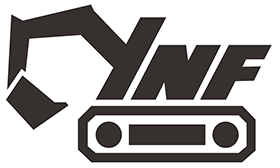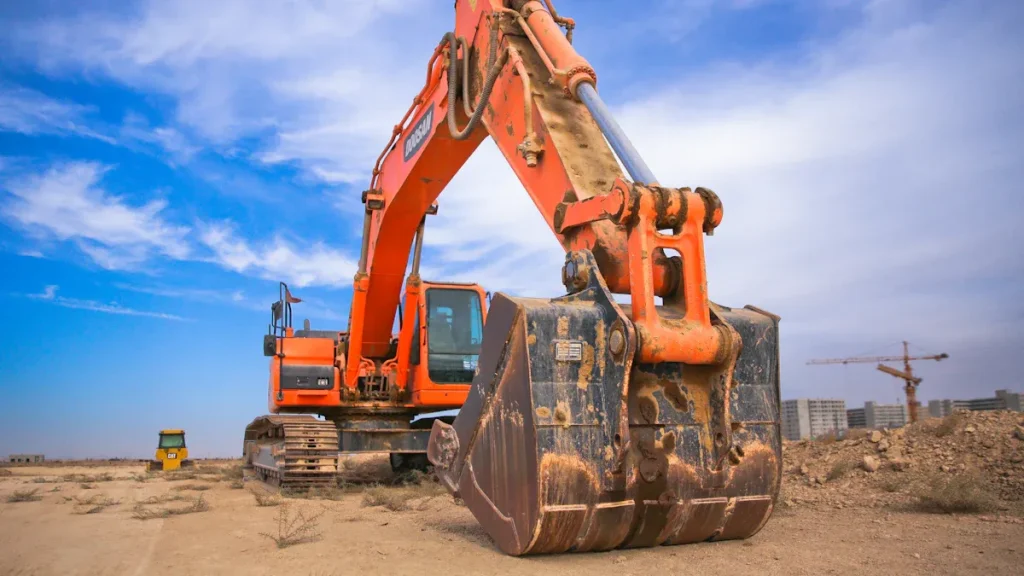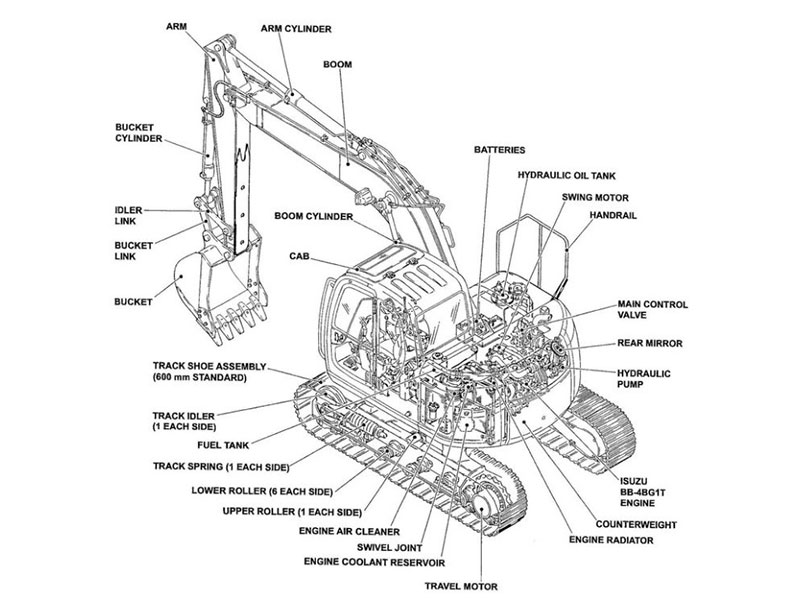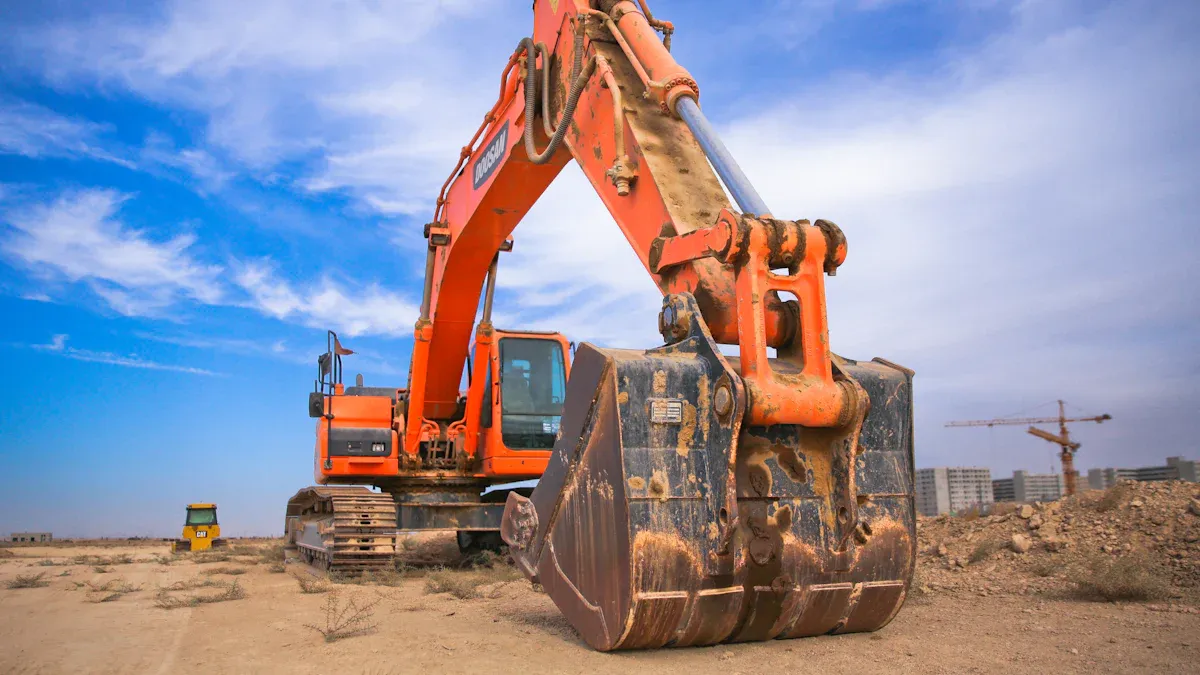
You use the excavator bucket to move dirt and rocks. It connects to the excavator arm and boom. The excavator bucket parts name list has the bucket shell, teeth, side cutters, cutting edge, adapters, wear plates, and pins. Each part helps with digging and moving things. If you know each excavator bucket parts name and job, you can use the excavator safely and well. Knowing how the bucket connects to the boom and arm also helps you take care of all excavator parts. This knowledge keeps your bucket and arm working their best.
Key Takeaways
Knowing what each excavator bucket part does helps you stay safe and work better. The bucket parts like teeth, cutting edge, and wear plates get worn out the most. These parts need to be checked and changed often. Taking care of the bucket by cleaning it and oiling the pins is important. Using real parts also helps your excavator last longer. If you know how the bucket connects to the arm and boom, you can find problems early. This helps keep the machine working well. Always follow safety rules before and while using the excavator. This keeps you safe and the machine in good shape.
Excavator Bucket Parts Name List
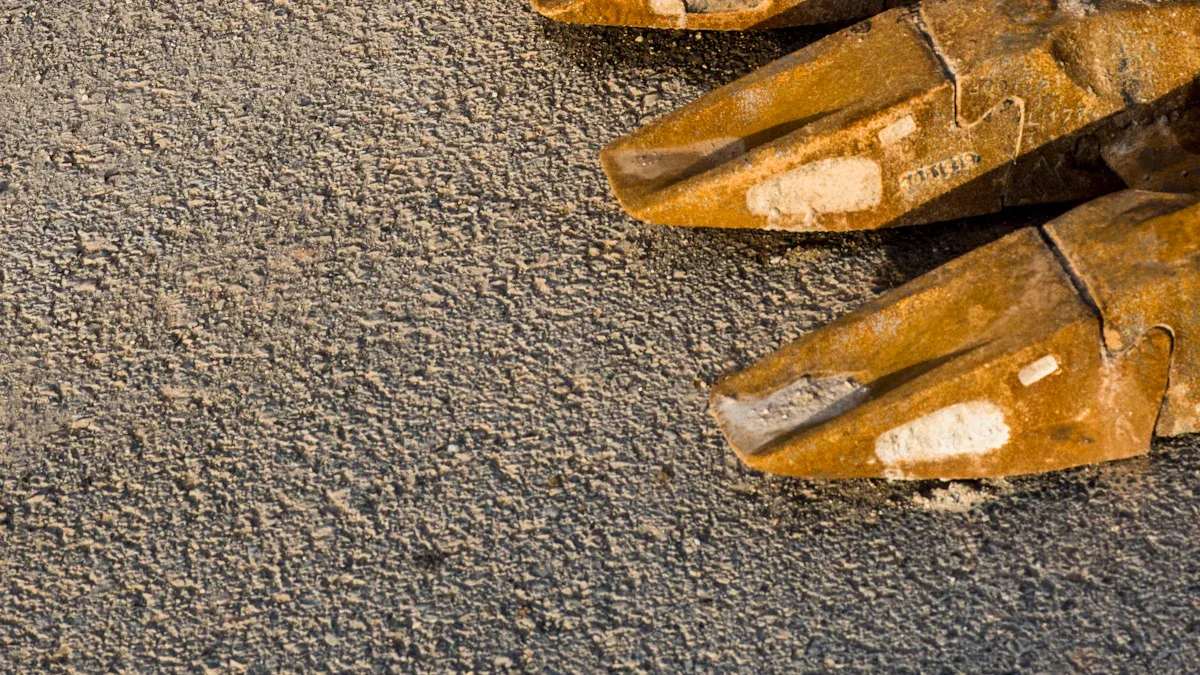
Bucket Shell
The bucket shell forms the main body of the excavator bucket. You see this as the large, curved metal structure that holds soil, rocks, or debris during digging. Manufacturers use high-grade, wear-resistant materials to build the shell. This choice helps the bucket last longer, even in tough conditions. Thicker shells give more strength and make it easier to attach or remove other excavator bucket parts. The shell’s design also keeps the bucket balanced, so your excavator works smoothly and efficiently.
Common materials for the bucket shell include:
High-strength steel for durability
Wear-resistant alloys for longer life
Modular options for easy repairs
A strong shell means you spend less time on maintenance and more time working.
Cutting Edge
The cutting edge sits at the very bottom front of the bucket. You use this part to slice into soil, clay, or rock. It acts like a sharp blade, making it easier for your excavator to dig and load material. The cutting edge often comes as a replaceable strip, so you can swap it out when it wears down. This part protects the bucket shell and helps keep your excavator parts in good shape.
Side Cutters
Side cutters attach to the left and right edges of the bucket. These parts help you cut through tough ground and protect the sides of the bucket from damage. When you dig near rocks or hard soil, side cutters take the hit first. You can replace them easily, which saves the main bucket from wearing out too quickly.
Teeth
Teeth stick out from the cutting edge. You use them to break up hard ground, rocks, or frozen soil. Each tooth digs into the earth, making it easier for the bucket to scoop up material. Teeth wear down over time, but you can replace them to keep your excavator bucket working at its best.
Adapters
Adapters connect the teeth to the cutting edge. You need these parts to hold the teeth firmly in place. Adapters let you change teeth quickly, so you can keep working without long delays. They also help spread the digging force across the cutting edge, which protects other excavator bucket parts.
Wear Plates
Wear plates cover the outside and sometimes the inside of the bucket shell. You rely on these plates to protect the bucket from scratches, dents, and heavy wear. Manufacturers use special alloys rich in hard chromium carbide particles to make wear plates. This material gives the plates high hardness and excellent resistance to wear, even in harsh conditions. Wear plates can last up to 30 times longer than regular steel, so you do not have to replace them often. They also help your excavator bucket handle high temperatures and impacts, making them essential for mining and construction work.
Tip: Regularly check your wear plates for damage. Replacing them on time keeps your bucket strong and your excavator parts safe.
Side Plates
Side plates form the vertical walls on each side of the bucket. These parts give the bucket its shape and add strength. Side plates also help guide material into the bucket during digging. If you notice dents or cracks in the side plates, you should repair them quickly to avoid bigger problems.
Bucket Ears
Bucket ears are thick metal tabs on the top of the bucket. You use these parts to connect the bucket to the excavator arm. The ears guide and fix the bucket in place, making sure it lines up with the arm’s tooth holder. Their special shape and guides make assembly easy and secure. Pins or keys hold the ears in place, giving you a strong and safe connection between the bucket and the excavator arm.
Lifting Eye
The lifting eye is a strong loop or ring welded to the bucket. You use this part to lift or move the bucket with chains or hooks. The lifting eye helps you handle heavy loads safely, especially when you need to transport the bucket or lift objects at the job site.
Heel Shrouds
Heel shrouds cover the lower back corners of the bucket. You rely on these parts to protect the bucket from wear when you drag it along the ground. Heel shrouds take the brunt of the friction, so the main bucket shell stays in better shape. You can replace heel shrouds when they wear out, which helps extend the life of your excavator bucket.
Lip Shrouds
Lip shrouds fit over the front edge of the bucket, right above the cutting edge and teeth. These parts shield the lip from damage during digging. Lip shrouds help prevent cracks and chips, so your bucket stays strong even after many hours of use.
Bosses
Bosses are thick, round metal pads welded to the bucket. You use these parts as mounting points for pins and bushings. Bosses help spread the load and keep the bucket securely attached to the excavator arm. If a boss wears out or cracks, you should fix it right away to avoid unsafe connections.
Pins and Bushings
Pins and bushings act as the moving joints between the bucket and the excavator arm. You insert pins through the bosses and bushings to hold the bucket in place. Bushings help the pins turn smoothly, reducing friction and wear. Keeping these parts well-lubricated and in good condition ensures your excavator bucket moves freely and safely.
Knowing each excavator bucket parts name and function helps you spot problems early. You can keep your excavator parts working longer and avoid costly repairs.
Excavator Bucket Assembly
How Parts Work Together
You control the excavator from the cab. When you move the controls, the excavator boom lifts or lowers. The excavator arm extends or pulls back. These movements guide the bucket into the ground. The boom and arm mechanism gives you the power to dig deep or reach far. The bucket connects to the excavator arm with strong pins and bushings. Bucket ears and bosses hold everything in place. The excavator boom supports the arm and bucket as you work.
Each part of the bucket has a job. The cutting edge and teeth break into the soil. Side cutters and lip shrouds protect the sides and front. Wear plates and heel shrouds keep the bucket strong. The lifting eye lets you move heavy loads safely. Adapters hold the teeth tight. Every time you dig, these excavator parts work together. The excavator boom and arm move the bucket smoothly. You get control and strength for every task.
Tip: Check the pins and bushings often. Good maintenance keeps the bucket moving with the excavator arm and boom.
Digging and Material Handling
You use the excavator for digging, lifting, and moving materials. The excavator boom raises the arm and bucket above the ground. The excavator arm pushes the bucket into the soil. The digging mechanism starts when you curl the bucket with the controls. The teeth and cutting edge break up dirt and rocks. The bucket shell holds the material. Side plates and wear plates guide and protect the load.
When you lift the bucket, the excavator boom and arm work together. The boom supports the weight. The arm keeps the bucket steady. You swing the excavator to move the load. The excavator boom and arm lower the bucket to dump the material. Every part of the excavator works as a team. You get smooth digging and safe handling every time.
Note: Knowing how the boom and arm mechanism works helps you use the excavator safely and efficiently.
Visual Guide
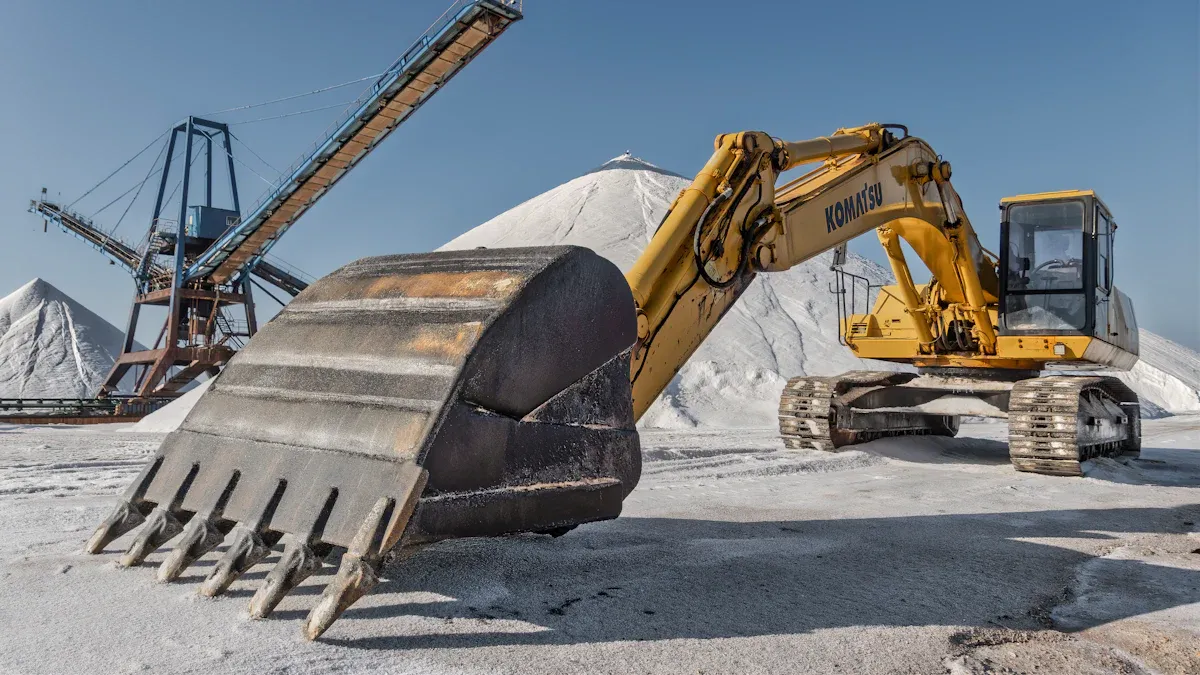
Diagram Overview
An excavator parts diagram helps you find each part fast. The diagram shows where every part is on the machine. You can see the main body, the arm, and the bucket. Labels and arrows point to each part in the diagram. You can find these diagrams in manuals or online guides. Training books also have them.
Tip: Keep a diagram close to where you work. Use it when you check or fix your machine.
A clear diagram helps you see how the excavator works. You can spot the bucket, arm, and boom. You also see small parts like pins, bushings, and teeth. Using a diagram helps you learn each part’s name and spot. This makes it easier to talk to mechanics or order new parts.
Labeled Parts
The table below is a quick guide. It matches labels from a diagram with what each part does. This table helps you remember each part’s job when you look at the diagram.
Label on Excavator Parts Diagram | Function |
|---|---|
Bucket Shell | Holds soil and rocks |
Cutting Edge | Slices into the ground |
Teeth | Breaks up hard material |
Side Cutters | Protects bucket sides |
Adapters | Connects teeth to cutting edge |
Wear Plates | Shields against wear |
Side Plates | Forms bucket walls |
Bucket Ears | Connects bucket to arm |
Lifting Eye | Lifts heavy loads |
Heel Shrouds | Guards bucket corners |
Lip Shrouds | Protects bucket lip |
Bosses | Mounts pins and bushings |
Pins and Bushings | Allows bucket movement |
You can use this table with any diagram. When you match the labels, you know what each part does. The diagram also helps you plan repairs or checkups. If you see damage in the diagram, you know which part to look at on your machine.
Note: A diagram is a great tool. It helps you learn and keeps your excavator working well.
Wear Points and Maintenance
High-Wear Parts
You will notice that some excavator bucket parts wear out faster than others. The teeth, cutting edge, side cutters, and wear plates face the most friction and impact during digging. These parts break into tough soil and rocks every day. Friction from abrasive materials causes the teeth and cutting edge to lose their sharpness. Impact from hitting stones or hard ground can bend or crack these parts. Wear plates and heel shrouds also take a lot of stress as you drag the bucket along the ground.
Tip: Check the teeth, cutting edge, and wear plates after each job. Early signs of wear help you avoid bigger problems.
Maintenance Tips
You can keep your excavator working longer with simple maintenance steps. Try these best practices:
Inspect all high-wear parts often. Look for cracks, chips, or thinning metal.
Clean the bucket after each use. Dirt and debris speed up wear if left on the parts.
Use original replacement parts when you need to swap out worn items. This keeps your excavator safe and reliable.
Lubricate pins and bushings to reduce friction and prevent breakdowns.
Train every operator to use the excavator correctly. Good handling protects the bucket, boom, and arm from extra stress.
Store your excavator in a covered area. Rain, snow, and sun can damage metal parts over time.
Keep a maintenance log. Write down every inspection and repair. This helps you plan for future part replacements.
Regular maintenance lowers repair costs and keeps your excavator ready for work. You will spend less time waiting for repairs and more time getting the job done.
A simple table can help you track what to check:
Part to Inspect | What to Look For | Action Needed |
|---|---|---|
Teeth | Wear, cracks, dull tips | Replace if damaged |
Cutting Edge | Thinning, chips | Replace if worn |
Wear Plates | Deep grooves, cracks | Replace as needed |
Pins & Bushings | Loose fit, rust | Lubricate or replace |
Remember: A well-maintained excavator lasts longer and works better. You protect your investment and avoid costly downtime.
Knowing about each excavator bucket part helps you use your machine safely. You need to understand how every part works before you start. When you sit in the excavator cab, always look around first. Make sure you can see everything outside the cab. Experts say you should follow these steps for safety:
Check the excavator cab and all parts before you use it.
Make sure you can see well from inside the cab.
Wear your helmet, gloves, and safety glasses in the cab.
Move the excavator cab slowly and do not make quick turns.
Keep every load balanced and never carry too much.
Mark the area around the cab and keep it safe.
Turn off the cab and put it away safely after work.
Always follow the safety rules when using the cab.
If you check your machine often and change worn parts on time, you will stay safe. Your excavator will also last longer and work better.
FAQ
What is the cab on an excavator?
You sit in the cab when you operate the machine. The cab protects you from weather and flying debris. You find all the controls inside the cab. You can see the job site clearly from the cab.
How do you keep the excavator cab clean?
You should sweep out dirt and dust from the cab every day. Wipe down the windows for a clear view. Remove trash from the cab after each shift. Clean controls and seats to keep the cab comfortable.
Why is it important to inspect the cab before use?
You need to check the cab for damage or loose parts. Make sure the seat and controls work well. A safe cab keeps you protected. Inspecting the cab helps you spot problems early.
Can you adjust the seat in the excavator cab?
Yes, you can move the seat in the excavator cab to fit your height. Adjust the seat so you reach all controls easily. A good seat position helps you stay comfortable and safe in the cab.
What should you do if you notice a problem with the cab?
Stop using the machine if you see damage in the cab. Report the problem to your supervisor. Do not use the excavator cab until repairs are complete. A safe cab is important for your protection.
